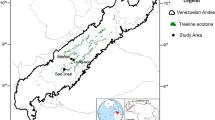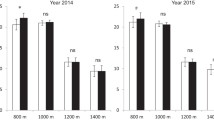Abstract
Variation in plant species performance in response to water availability offers a potential axis for temporal and spatial habitat partitioning and may therefore affect community composition in tropical forests. We hypothesized that short dry spells during the wet season are a significant source of mortality for the newly emerging seedlings of pioneer species that recruit in treefall gaps in tropical forests. An analysis of a 49-year rainfall record for three forests across a rainfall gradient in central Panama confirmed that dry spells of ≥10 days during the wet season occur on average once a year in a deciduous forest, and once every other year in a semi-deciduous moist and an evergreen wet forest. The effect of wet season dry spells on the recruitment of pioneers was investigated by comparing seedling survival in rain-protected dry plots and irrigated control plots in four large artificially created treefall gaps in a semi-deciduous tropical forest. In rain-protected plots surface soil layers dried rapidly, leading to a strong gradient in water potential within the upper 10 cm of soil. Seedling survival for six pioneer species was significantly lower in rain-protected than in irrigated control plots after only 4 days. The strength of the irrigation effect differed among species, and first became apparent 3–10 days after treatments started. Root allocation patterns were significantly, or marginally significantly, different between species and between two groups of larger and smaller seeded species. However, they were not correlated with seedling drought sensitivity, suggesting allocation is not a key trait for drought sensitivity in pioneer seedlings. Our data provide strong evidence that short dry spells in the wet season differentially affect seedling survivorship of pioneer species, and may therefore have important implications to seedling demography and community dynamics.





Similar content being viewed by others
References
Ashton PMS (1992) Some measurements of the microclimate within a Sri-Lankan tropical rainforest. Agr For Meteorol 59:217–235
Augspurger CK (1984) Light requirements of neotropical tree seedlings: a comparative study of growth and survival. J Ecol 72:777–795
Becker P (1987) Monthly average solar radiation in Panama—daily and hourly relations between direct and global insolation. Solar Energy 39:445–453
Becker P (1992) Seasonality of rainfall and drought in Brunei Darussalam. Brunei Mus J 7:99–109
Becker P, Rabenold PE, Idol JR, Smith AP (1988) Water potential gradients for gaps and slopes in a Panamanian tropical moist forest’s dry season. J Trop Ecol 4:173-184
Bond WJ, Honig M, Maze KE (1999) Seed size and seedling emergence: an allometric relationship and some ecological implications. Oecologia 120:132–136
Brandani A, Hartshorn GS, Orians GH (1988) Internal heterogeneity of gaps and species richness in Costa Rican tropical wet forest. J Trop Ecol 4:99–109
Brokaw NVL (1987) Gap-phase regeneration of three pioneer tree species in a tropical forest. J Ecol 75:9–19
Brown ND (1993) The implications of climate and gap microclimate for seedling growth conditions in a Bornean lowland rainforest. J Trop Ecol 9:153–168
Brown ND, Whitmore TC (1992) Do dipterocarp seedlings really partition tropical rain forest gaps? Philos Trans R Soc Lond B 335:369–378
Burslem DFRP, Grubb PJ, Turner IM (1996) Responses to simulated drought and elevated nutrient supply among shade-tolerant tree seedlings of lowland tropical forest in Singapore. Biotropica 28:636–646
Condit R, Hubbell SP, Foster RB (1995) Mortality rates of 205 neotropical tree and shrub species and the impact of severe drought. Ecol Monogr 65:419–439
Dalling JW, Hubbell SP (2002) Seed size, growth rate and gap microsite conditions as determinants of recruitment success for pioneer species. J Ecol 90:557–568
Dalling JW, Swaine MD, Garwood NC (1997) Soil seed bank community dynamics in seasonally moist lowland forest, Panama. J Trop Ecol 13:659–680
Dalling JW, Hubbell SP, Silvera K (1998) Seed dispersal, seedling establishment and gap partitioning among tropical pioneer trees. J Ecol 86:674–689
Dalling JW, Lovelock CE, Hubbell SP (1999) Growth responses of seedlings of two neotropical pioneer species to simulated forest gap environments. J Trop Ecol 15:827–839
Dalling JW, Hubbell SP, Winter K (2004) Variation in growth responses of neotropical pioneers to simulated forest gaps. Funct Ecol 18:725–736
Daws MI, Burslem DFRP, Crabtree LM, Kirkman P, Mullins CE, Dalling JW (2002) Differences in seed germination responses may promote coexistence of four sympatric Piper species. Funct Ecol 16:258–267
Delissio LJ, Primack RB (2003) The impact of drought on the population dynamics of canopy-tree seedlings in an aseasonal Malaysian rain forest. J Trop Ecol 19:489–500
Draper NR, Smith H (1998) Applied regression analysis, 3rd edn. Wiley, New York
Dytham C (1999) Choosing and using statistics. A biologist’s guide. Blackwell, Oxford
Engelbrecht BMJ, Kursar TA (2003) Comparative drought-resistance of seedlings of 28 species of co-occurring tropical woody plants. Oecologia 136:383–393
Engelbrecht BMJ, Kursar TA, Tyree MT (2005) Drought effects on seedling survival in a tropical moist forest trees. Trees Struct Funct 19:312–321
ESP (2005) Environmental Science Program of the Smithsonian Tropical Research Institute. http://www.striweb.si.edu/esp/. Cited March 2005
Evans CE, Etherington JR (1990) The effect of soil water potential on seed germination of some British plants. New Phytol 115:539–548
Fisher BL, Howe HF, Wright SJ (1991) Survival and growth of Virola surinamensis yearlings: water augmentation in gap and understory. Oecologia 86:292–297
Garwood NC (1982) Seasonal rhythm of seed germination in a semideciduous tropical forest. In: Leigh Jr EG, Rand AS, Windsor DM (eds) The ecology of a tropical forest: seasonal rhythms and long-term changes. Smithsonian Institution Press, Washington, pp 173–199
Gentry AH (1988) Changes in plant community diversity and floristic composition on environmental and geographical gradients. Ann Mo Bot Gard 75:1–34
Hawkins BA, Field R, Cornell HV, Currie DJ, Guegan J-F, Kaufman DM, Kerr JT, Mittelbach GG, Oberdorff T, O’Brien EM, Porter EE, Turner JR (2003) Energy, water, and broad-scale geographic patterns of species richness. Ecology 84:3105–3117
Healey JR (1990) Regeneration in a Jamaican montane tropical rain forest. PhD Dissertation, University of Cambridge
Leigh EG Jr (1999) Tropical forest ecology. A view from Barro Colorado Island. Oxford University Press, Oxford
Lieth H (1975) Primary production of the major vegetation units of the world. In: Lieth H, Whittaker RH (eds) Primary productivity of the biosphere. Springer, Berlin Heidelberg New York, pp 203–231
Lloret F, Casanovas C, Penuelas J (1999) Seedling survival of Mediterranean shrubland species in relation to root:shoot ratio, seed size and water and nitrogen use. Funct Ecol 13:210–216
Mulkey SS, Wright SJ (1996) Influence of seasonal drought on the carbon balance of tropical forest plants. In: Smith AP, Mulkey SS, Chazdon RL (eds) Tropical forest plant ecophysiology. Chapman and Hall, New York, pp 187–216
Pearson TRH, Burslem DFRP, Mullins CE, Dalling JW (2002) Germination ecology of neotropical pioneers: interacting effects of environmental conditions and seed size. Ecology 83:2798–2807
Pearson TRH, Burslem DFRP, Goeriz RE, Dalling JW (2003a) Interactions of gap size and herbivory on establishment, growth and survival of three species of neotropical pioneer trees. J Ecol 91:785–796
Pearson TRH, Burslem DFRP, Goeriz RE, Dalling JW (2003b) Regeneration niche partitioning in neotropical pioneers: effects of gap size, seasonal drought and herbivory on growth and survival. Oecologia 137:456–465
Pearson TRH, Burslem DFRP, Mullins CE, Dalling JW (2003c) Functional significance of photoblastic germination in neotropical pioneer trees: a seed’s eye view. Funct Ecol 17:394–402
Poorter L, Hayashida-Oliver Y (2000) Effects of seasonal drought on gap and understory seedlings in a Bolivian moist forest. J Trop Ecol 16:481–498
Potts MD (2003) Drought in a Bornean everwet rain forest. J Ecol 91:467–474
Reader R, Jalili A, Grime JP, Spencer RE, Matthews N (1992) A comparative study of plasticity in seedling rooting depth in drying soil. J Ecol 81:543–550
Rice WR (1989) Analyzing tables of statistical tests. Evolution 43:223–225
Sperry JS, Adler FR, Campbell GS, Comstock J (1998) Limitation of plant water use by rhizosphere and xylem conductance: results from a model. Plant Cell Environ 21:347–359
Swaine MD, Whitmore TC (1988) On the definition of ecological species groups in tropical rain forests. Vegetatio 75:81–86
Tyree MT, Zimmermann MH (2002) Xylem structure and the ascent of sap. Springer, Berlin Heidelberg New York
Tyree MT, Engelbrecht BMJ, Vargas G, Kursar TA (2003) Desiccation tolerance of five tropical seedlings in Panama: relationship to a field assessment of drought-performance. Plant Physiol 132:1439–1447
van der Meer PJ, Sterck FJ, Bongers F (1998) Tree seedling performance in canopy gaps in a tropical rainforest at Nouragues, French Guiana. J Trop Ecol 14:119–137
Vásquez-Yanes C, Smith H (1982) Phytochrome control of seed germination in the tropical rain forest pioneer trees Cecropia obtusifolia and Piper auritum and its ecological significance. New Phytol 92:477–485
Vazquez-Yanes C, Orozco-Segovia A, Rincon E, Sanchez-Coronado ME, Huante P, Toledo JR, Barradas VL (1990) Light beneath the litter in a tropical forest: effect on seed germination. Ecology 71:1952–1958
Veenendaal EM, Swaine MD (1998) Limits to tree species distributions in lowland tropical rainforests. In: Newbery DM, Prins HHT, Brown ND (eds) Dynamics of tropical communities. Blackwell, Oxford, pp 163–191
Veenendaal EM, Swaine MD, Agyeman VK, Blay D, Abebrese IK, Mullins CE (1995) Differences in plant and soil water relations in and around a forest gap in West Africa during the dry season may influence seedling establishment and survival. J Ecol 83:83–90
Walsh RPD, Newbery DM (1999) The ecoclimatology of Danum, Sabah, in the context of the world’s rainforest regions, with particular reference to dry periods and their impact. Philos Trans R Soc Lond B 354:1391–1405
Yavitt JB, Wright SJ (2001) Drought and irrigation effects on fine root dynamics in a tropical moist forest, Panama. Biotropica 33:421–434
Acknowledgements
We thank Maria Pickering, Amy Faivre, Lauren Schachner and Didimo Moran for assistance with the field experiment, and Susanne Aref, Rachel Gallery and David Moore for statistical advice. We also thank all the BCI residents for their timely help in preparing seeds, for their willingness to spend evenings sorting toothpicks, as well as for moral support. The Smithsonian Tropical Research Institute provided excellent logistical support. Rainfall data were provided by the Terrestrial-Environmental Sciences Program of the Smithsonian Tropical Research Institute and by the Meteorology and Hydrology Branch of the Panama Canal Authority, Republic of Panama. The project was funded by the University of Utah, the USDA Forest Service, The Andrew W. Mellon Foundation and The Leverhulme Trust.
Author information
Authors and Affiliations
Corresponding author
Additional information
Communicated by Jim Ehleringer
Rights and permissions
About this article
Cite this article
Engelbrecht, B.M., Dalling, J.W., Pearson, T.R. et al. Short dry spells in the wet season increase mortality of tropical pioneer seedlings. Oecologia 148, 258–269 (2006). https://doi.org/10.1007/s00442-006-0368-5
Received:
Accepted:
Published:
Issue Date:
DOI: https://doi.org/10.1007/s00442-006-0368-5




